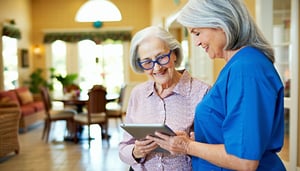Running a Senior Living community or Care Home is never simple. Every day brings its own small challenges — keeping residents comfortable, managing inspections, tracking staff workloads, staying on top of food safety, and a hundred other details no one sees. Some days it all clicks. Other days... well, things get missed.
Perhaps that’s inevitable. Or perhaps it's a sign that Senior Living communities and Care Homes deserve better support for their daily operations.
Smarter monitoring technologies have made it possible to track more, notice more, and intervene earlier — without burying staff under even more admin. Used well, they can make operations more efficient, compliant, and ultimately, more resident-centred.
The everyday challenges of Senior Living and Care Home operations
There is no shortage of operational hurdles in Senior Living and Care Home environments. And they rarely wait their turn.
Staff shortages are a reality most managers know too well. With limited hands, tasks like checking fridge temperatures, logging maintenance requests, or updating resident records can slip down the priority list. Not because staff don't care — but because they're stretched thin, reacting to the immediate needs of residents.
Manual record-keeping, once the gold standard, now feels more like a burden. Paper logs can be incomplete, misplaced, or simply forgotten in the rush of daily life. The risk isn't just operational — it's regulatory. Audits, inspections, and quality assurance reviews all demand accurate records, and manual systems make that harder to guarantee.
And then there’s the resident experience itself. When operational gaps appear — a cold room left unattended, a delayed meal, a missed maintenance issue — satisfaction drops. Rightly so.
The role of smarter monitoring in daily operations
Some may think digital monitoring is only about data collection. In reality, it’s more than that. It's a shift in how organisations manage time, resources, and focus.
Real-time visibility means staff no longer need to manually check temperatures or equipment conditions on a schedule. They can see issues developing — or even better, get alerted before they become problems.
Automated task management changes how routine work gets done. Scheduled checks, cleaning tasks, maintenance inspections — they can all be digitally assigned, tracked, and verified without the constant need for clipboard checks.
Data-driven insights reveal patterns human memory often misses. If certain shifts are prone to missing checks, or a fridge consistently operates at the wrong temperature, smarter monitoring spots it long before it surfaces during an inspection.
And importantly, audit readiness becomes a by-product of everyday operations — not a mad scramble when an inspector phones ahead.
Of course, technology isn't a silver bullet. It still requires thoughtful implementation and staff engagement. But where used well, it can lift the unseen operational burden, freeing teams to focus on what matters most: resident care.
Practical examples: What smarter monitoring looks like day-to-day
Here’s where theory meets reality.
- Food service safety: Automated monitoring of fridge and freezer temperatures replaces manual spot checks. Alerts trigger before safe limits are breached, helping prevent food safety issues before they escalate.
- Resident comfort: Environmental sensors keep an eye on room conditions — too cold, too hot, or just right. It’s a small thing that makes a big difference to resident wellbeing.
- Preventative maintenance: Monitoring systems track maintenance needs in real time, flagging issues like boiler performance or air conditioning failures early, not after the fact.
- Smoother shift handovers: Digital task records ensure that information isn't lost during handovers. No more relying on scribbled notes or “Did you remember to…” conversations.
None of these on their own change the world. But layered together, they add up to real operational resilience.
The outcomes: Less chaos, more care
With smarter monitoring, Senior Living communities and Care Homes can expect to see tangible improvements.
Staff spend less time chasing paperwork and more time with residents. Compliance becomes embedded in daily life rather than a separate burden. Resident experiences improve — sometimes in small ways, sometimes dramatically. And when surprises do happen, teams are better equipped to react swiftly and confidently.
It’s not perfect, of course. No system, no process, no technology ever is. But it’s a shift. A chance to rethink operations from the ground up — prioritising people, supported by technology, instead of weighed down by it.
Closing thought
Optimising operations isn’t about adding layers of complexity. It’s about simplifying the essential tasks that support resident care.
Smarter monitoring offers one way forward. Not the only way — but perhaps, for many Senior Living communities and Care Homes, the most practical place to begin.



